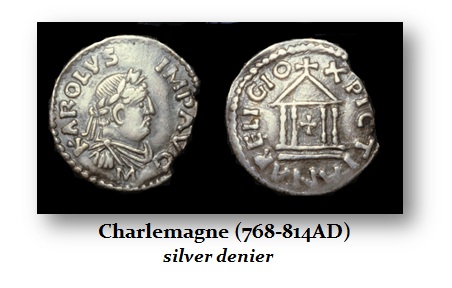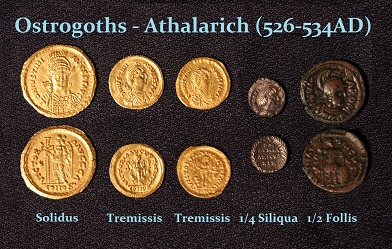Vikings
Posted Apr 10, 2016 by Martin Armstrong
QUESTION: Marty, I have not seen you write about the Vikings. Did you take their rise and fall into consideration in your model?
YC
ANSWER: Of course. The monetary history of the Vikings is tied to England as well as Global Warming. The rise of the Vikings was due to Global Warming from a natural cyclical trend which the current nonsense ignores. The rise of the Vikings coincided with the Medieval Warm Period (800–1250) and stopped with the start of the Little Ice Age (about 1250–1850). The climate directly influenced the rise and fall of the Vikings. Moreover, we now know that the Vikings established a settlement for a while in America about 500 years before Columbus.
To understand cycles, you must also understand the whole. The discovery of America was by Leif Erikson (c. 970 – 1020). As the Vikings were rising, Byzantium was declining. The Vikings had no coinage of their own. As the climate warmed, the Vikings grew in power and were able to explore reaching even America. Their invasion of England was like the barbarians invading Rome. They adopted the ways and culture of the English and began to even adopt the idea of coinage. The English tried to buy the Vikings off paying them vast amounts of silver to go away. They kept coming back and to this day, there are often more English silver pennies discovered in Scandinavia than in England from this period in time (Viking hoards, see also Cuerdale Hoard of more than 8,600 silver items on display in British Museum).
 The beginning of the Viking Age is marked by the sack of the Holy Island of Lindisfarne which is a tidal island off the northeast coast of England. This event also coincided with Charlemagne’s (768-814) Saxon War which was a Christian war against the pagans in Saxony. The Viking attacks may have been actually a response to the spread of Christianity among pagan peoples since it coincides with the reign of Charlemagne and the attempt to spread Christianity in Scandinavia.
The beginning of the Viking Age is marked by the sack of the Holy Island of Lindisfarne which is a tidal island off the northeast coast of England. This event also coincided with Charlemagne’s (768-814) Saxon War which was a Christian war against the pagans in Saxony. The Viking attacks may have been actually a response to the spread of Christianity among pagan peoples since it coincides with the reign of Charlemagne and the attempt to spread Christianity in Scandinavia.Clearly, the Scandinavians were prejudiced by Christians who would not trade with heathens (Pagans) and infidels (Muslims). This created the breakdown in trade relations which furthered simple Viking raiding parties invading Britain. A two-tiered system of pricing existed with both declared and undeclared merchants trading secretly with banned parties. Simultaneously, the warm weather created a population boom and the Scandinavian population became too large for the region creating the incentive to seek more farmland for everyone. Many Vikings resisted the rising royalty claims at home and began to migrate elsewhere. Iceland became Europe’s first modern republic established by Vikings against monarchy, with an annual assembly of elected officials called the Althing, though only goði (wealthy landowners) had the right to vote there. Iceland was first populated around the 870’s by the Norwegian Viking explorer Ingolfr Arnason, who was driven to seek new lands as the result of a blood feud between himself and his enemies in his native land. The Vikings established the settlement that later became Reykjavík, meaning ‘Smoky Cove’ (a reference to the visible volcanic activity in the area).
The earliest date which has been given for a Viking raid is 789 AD when, according to the Anglo-Saxon Chronicle, a group of men from Norway sailed to the Isle of Portland in Dorset. There, they were mistaken for merchants by a royal official who they murdered when he tried to get them to accompany him to the king’s manor to pay a trading tax on their goods. Foreign traders where going to Britain since the Minoans pre-1600BC. The viking raids were profitable and expanded as the Anglo-Saxon Chronicle recorded an attack on a island monastery of Lindisfarne in 793AD.

 According to the Annals of Ulster, in 794AD there was a major raid on Iona, which was followed the next year with raids on northern coast of Ireland in 795, the island of Rathlin. They plundered silver and also stole their women. The end of the Viking Age is normally marked in England by the failed invasion attempted by the Norwegian king Harald III, who was defeated by Saxon King Harold Godwinson in 1066 at the Battle of Stamford Bridge. In Ireland, however, the capture of Dublin took place in 1171 and then in 1263 in Scotland they were defeated by troops loyal to Alexander III.
According to the Annals of Ulster, in 794AD there was a major raid on Iona, which was followed the next year with raids on northern coast of Ireland in 795, the island of Rathlin. They plundered silver and also stole their women. The end of the Viking Age is normally marked in England by the failed invasion attempted by the Norwegian king Harald III, who was defeated by Saxon King Harold Godwinson in 1066 at the Battle of Stamford Bridge. In Ireland, however, the capture of Dublin took place in 1171 and then in 1263 in Scotland they were defeated by troops loyal to Alexander III.
Cnut the Great (c. 995– 1035), was a king of Denmark, England, Norway and parts of Sweden, who was perhaps the king of the Anglo-Scandinavian North Sea Empire. Cnut himself was Danish, not British or Anglo-Saxon.Following his death and the deaths of his heirs within a decade, this is when we see the Norman conquest of England in 1066.

William, Duke of Normandy was actually a Viking descendant since they had been conquered back in 911AD. Norman culture took over England in 1066. With the Norman Conquest, they became the ruling aristocracy of Anglo-Saxon England. Scotland regained its territory from the Norse between the 13th and the 15th centuries; the Western Isles and the Isle of Man remained under Scandinavian authority until 1266. Orkney and Shetland belonged to the king of Norway as late as 1469.
 We can see that the Vikings created a northern empire from about 842 to 1066 lasting one political cycle of 224 years. Normandy was rising as Byzantium was falling. The real shock came during the Great Monetary Crisis of 1092. The debasement of the Byzantine gold coinage took on a real momentum as finances went into deficit starting around 1066. Former money changer/forger of coins Michael IV the Paphlagonian (1034–41) assumed the throne of Byzantium in 1034 after the Empress Zoe fell in love with him. It was this money changer who began the slow process of debasing both the gold coinageknown as the tetarteron nomisma and the histamenon nomisma. The debasement was gradual at first, but then accelerated rapidly from 24 carats to about 21 carats (87.5% pure) yet the weight remained the same.
We can see that the Vikings created a northern empire from about 842 to 1066 lasting one political cycle of 224 years. Normandy was rising as Byzantium was falling. The real shock came during the Great Monetary Crisis of 1092. The debasement of the Byzantine gold coinage took on a real momentum as finances went into deficit starting around 1066. Former money changer/forger of coins Michael IV the Paphlagonian (1034–41) assumed the throne of Byzantium in 1034 after the Empress Zoe fell in love with him. It was this money changer who began the slow process of debasing both the gold coinageknown as the tetarteron nomisma and the histamenon nomisma. The debasement was gradual at first, but then accelerated rapidly from 24 carats to about 21 carats (87.5% pure) yet the weight remained the same. During the reign of Constantine IX (1042–1055), the color of the coinage begins to become more noticable with a pale yellow falling to 18 carats (75%). Under Constantine X (1059–1067), the gold content fell to 16 carats (66.7%) and then under Romanus IV (1068–1071), it fell to 14 carats (58%). By Michael VII (1071–1078), the gold content collapsed to 8 carats (33%). During the first eleven years of the reign of Alexius I (1081–1118), the gold content was debased to the point that it no longer existed and then even the silver coinage was debased. Finally, Alexius I Comnenus was forced to end the debasement as Byzantine coins would not longer be accepted in trade. After losing international recognition and having to ask for help (bailout) from the Western Europe (Venetians), the gold coinage of higher fineness (generally .900-.950) was reestablished established as a result of the Great Monetary Crisis of 1092. The hyperpyron was introduced at 4.45 grams.
During the reign of Constantine IX (1042–1055), the color of the coinage begins to become more noticable with a pale yellow falling to 18 carats (75%). Under Constantine X (1059–1067), the gold content fell to 16 carats (66.7%) and then under Romanus IV (1068–1071), it fell to 14 carats (58%). By Michael VII (1071–1078), the gold content collapsed to 8 carats (33%). During the first eleven years of the reign of Alexius I (1081–1118), the gold content was debased to the point that it no longer existed and then even the silver coinage was debased. Finally, Alexius I Comnenus was forced to end the debasement as Byzantine coins would not longer be accepted in trade. After losing international recognition and having to ask for help (bailout) from the Western Europe (Venetians), the gold coinage of higher fineness (generally .900-.950) was reestablished established as a result of the Great Monetary Crisis of 1092. The hyperpyron was introduced at 4.45 grams.
This coincided with the Battle of Hastings as Europe was rising up against the Vikings. The next 26 years saw the capitulation of Byzantium. This was the fall of Byzantium since their gold coins had been the dominant world currency called a Byzant. From 1066 onward, their monetary system lost all prestige and the restoration in 1092 was a brief attempt to regain their status.

 The monetary system of the Vikings was silver based, not gold. They played an important role in the development of Europe. The period following the fall of Rome was dominated by various barbarian tribes who sought to also adopt the Roman ways. They issued coins imitating Roman exactly as the Vikings did with respect to English coinage. Gold remained imitated in Western Europe until about 618AD. Then we have another gap of about 224 years within Western Europe.
The monetary system of the Vikings was silver based, not gold. They played an important role in the development of Europe. The period following the fall of Rome was dominated by various barbarian tribes who sought to also adopt the Roman ways. They issued coins imitating Roman exactly as the Vikings did with respect to English coinage. Gold remained imitated in Western Europe until about 618AD. Then we have another gap of about 224 years within Western Europe.
No comments:
Post a Comment